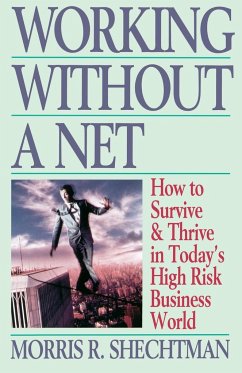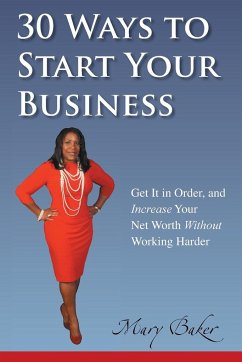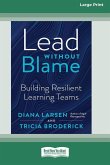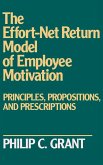18,99 €
inkl. MwSt.
Versandfertig in 1-2 Wochen

9 °P sammeln
- Broschiertes Buch
- Merkliste
- Auf die Merkliste
- Bewerten Bewerten
- Teilen
- Produkt teilen
- Produkterinnerung
- Produkterinnerung
Endorsed by Speaker of the House Newt Gingrich, Working Without a Net is a thought-provoking management book which offers growth and success strategies, powerful exercises, and practical, self-motivating "rules of the game" to help managers compete successfully in today's high-risk business environment. Major media attention.
Andere Kunden interessierten sich auch für
![30 Ways to Start Your Business, Get It in Order, and Increase Your Net Worth Without Working Harder 30 Ways to Start Your Business, Get It in Order, and Increase Your Net Worth Without Working Harder]() Mary Baker30 Ways to Start Your Business, Get It in Order, and Increase Your Net Worth Without Working Harder15,99 €
Mary Baker30 Ways to Start Your Business, Get It in Order, and Increase Your Net Worth Without Working Harder15,99 €![Net working capital versus marketing in agriculture sector of Turkey Net working capital versus marketing in agriculture sector of Turkey]() Ali Faruk AcikgozNet working capital versus marketing in agriculture sector of Turkey24,99 €
Ali Faruk AcikgozNet working capital versus marketing in agriculture sector of Turkey24,99 €![Swim with the Sharks Without Being Eaten Alive Swim with the Sharks Without Being Eaten Alive]() Harvey B MacKaySwim with the Sharks Without Being Eaten Alive16,99 €
Harvey B MacKaySwim with the Sharks Without Being Eaten Alive16,99 €![Strengthening Asia's Financial Safety Net Strengthening Asia's Financial Safety Net]() Asian Development BankStrengthening Asia's Financial Safety Net28,99 €
Asian Development BankStrengthening Asia's Financial Safety Net28,99 €![Lead Without Blame Lead Without Blame]() Diana LarsenLead Without Blame38,99 €
Diana LarsenLead Without Blame38,99 €![Net Zero, Food and Farming Net Zero, Food and Farming]() Neil WardNet Zero, Food and Farming185,99 €
Neil WardNet Zero, Food and Farming185,99 €![The Effort-Net Return Model of Employee Motivation The Effort-Net Return Model of Employee Motivation]() Philip C. GrantThe Effort-Net Return Model of Employee Motivation94,99 €
Philip C. GrantThe Effort-Net Return Model of Employee Motivation94,99 €-
-
-
Endorsed by Speaker of the House Newt Gingrich, Working Without a Net is a thought-provoking management book which offers growth and success strategies, powerful exercises, and practical, self-motivating "rules of the game" to help managers compete successfully in today's high-risk business environment. Major media attention.
Hinweis: Dieser Artikel kann nur an eine deutsche Lieferadresse ausgeliefert werden.
Hinweis: Dieser Artikel kann nur an eine deutsche Lieferadresse ausgeliefert werden.
Produktdetails
- Produktdetails
- Verlag: Fireside
- Seitenzahl: 272
- Erscheinungstermin: 1. Mai 1995
- Englisch
- Abmessung: 216mm x 140mm x 16mm
- Gewicht: 388g
- ISBN-13: 9780671535810
- ISBN-10: 0671535811
- Artikelnr.: 21741394
- Herstellerkennzeichnung
- Libri GmbH
- Europaallee 1
- 36244 Bad Hersfeld
- gpsr@libri.de
- Verlag: Fireside
- Seitenzahl: 272
- Erscheinungstermin: 1. Mai 1995
- Englisch
- Abmessung: 216mm x 140mm x 16mm
- Gewicht: 388g
- ISBN-13: 9780671535810
- ISBN-10: 0671535811
- Artikelnr.: 21741394
- Herstellerkennzeichnung
- Libri GmbH
- Europaallee 1
- 36244 Bad Hersfeld
- gpsr@libri.de
Morris R. Shechtman is an internationally known change management consultant and Chairman of The Shechtman Institute. His clients include Arthur Andersen, ConAgra, Northwestern Mutual Life, and the Young President's Organization (YPO). Mr. Shechtman has brought about remarkable gains in individual and collective productivity by teaching managers how to become agents of personal growth and development.
Contents
PREFACE
PART ONE: Surviving the High Risk Culture
Chapter 1
An Alternative to Working and Living in a Fantasy world
* Keeping the Safety Nets in Place
* Why It Doesn't Work Anymore
* A Great Capacity for Change
* Benefits of Working without a Net
* How I Know What I Know
* A Caring Approach
* How This Book Will Facilitate Your Ability to Grow and Manage Growth
* An Alternative to the Typical Management Book
Chapter 2
Six Paradigms for Keeping your Balance in a High Risk Culture
* Paradigm 1: Caring for People Is Not Synonymous with Taking Care of
People
* Paradigm 2: People's Ability to Change Is Not a Function of Capacity but
of Choice
* Paradigm 3: We Need To Change Our Attitudes Toward Change
* Paradigm 4: We Must Redefine What Constitutes Acceptable Work, Moving
from Adequacy to Peak Performance
Paradigm 5: Who We Are Personally Is Inextricably Connected to Who We Are
Professionally; the Goal Is to Lead Blended, Not Balanced, Lives
* Paradigm 6: We Must Create Value-Driven Personal and Professional Lives
* A New Way to View the World
Chapter 3
The Impact of Information on Competitive Advantage
* Expect New Expectations
* Impact One: Increased Competition
* Impact Two: Decreased Profits and Margins
* Impact Three: People Are the Competitive Edge
* But What About Price?
* Being Open to Information
Chapter 4
Decision-Making and the Information Cycle
* From Information to Choices
* From Choices to Decisions
* From Decisions to Change
* From Change to Information
* How People Make Decisions
* Decision-Making Can Be Taught
* Teach Yourself How to Make High Risk Decisions
* The Only Way Out
* Working with the Cycle (Instead of It Working Against You)
Chapter 5
Relationship-Building: Moving from Schmoozing to Intimacy
* Prerequisite One: A High Drive for Growth
* Prerequisite Two: A Capacity for Intimacy
* Prerequisite Three: Honest and Direct Communication
* Prerequisite Four: A Transition from High Maintenance to Low Maintenance
Relationships
* Blending Our Lives
Chapter 6
The High Risk Culture
* Autonomy Versus Security
* Trade-offs
* But What If We Opt for Low Risk?
* Doing Business in a Shrinking World
* How We Avoid Conflict
* Signs of the High Risk Shift
* Identifying High Risk People
* Paying the Price
PART TWO: Growth and Success
Chapter 7
Growth and Success: High Risk Models and Tools
* Entrepreneurial Versus Corporate
* Entrepreneurial Traits
* Pinpointing the Problem: A Diagnostic Tool
* Starting at the Top: A Remedy
* Other Effects of Success and Growth
* The Dilemma of Developing Successful People
* Helping Everyone Make the Transition
Chapter 8
Individual Growth and Success: Learning to Cope with Loss
* What We Gain and What We Lose
* Losing the Familiar
* Loss of Roots
* The Loss of Necessary Limits
* The Function of Goals
* How to Keep Choosing New Limits
Chapter 9
Success and Growth as a Grieving Process
* Stage One: Shock and Denial
* Stage Two: Anger
* Stage Three: Bargaining
* Stage Four: Depression
* Stage Five: Acceptance
* Why Now?
PART THREE: Overcoming common Obstacles
Chapter 10
Clarifying Confused Values
* The Value Clarification Instrument
* Evaluating the Profile
* How To Move Toward High Risk Positions
* Organizational Uses of the Instrument
* One Final Note About Scores
Chapter 11
Coping with Delayed Development
* The Secret Impact of Technology: Prolonged Adolescence
* The New Developmental Stages
* How to Deal with Adolescent Worker
* How to Deal with Young Adults
* How to Deal with Adults
* The Gray Areas
* Three Requirements for Managing Stages
Chapter 12
Accountability: The Seven Prerequisites
* The Value of Accountability
* 1. Accountability Is to Individuals; Not to Groups, Committees, or
Organizations
* 2. Clarify the Areas in Which One Will Be Held Accountable
* 3. Expectations Must Be Stated in a Specific and Clearly Differentiating
Manner
* 4. Measurement of Expectations Must Delineate Quantity and Time Frame
* 5. Consequences for Meeting or Failing to Meet Established Expectations
Must Be Stated in Detail
* 6. Consequences Must Be Enacted with Immediacy, Objectivity, and Clarity
* 7. Accountability Must Be Consistently Modeled by Top Management
* The Accountability Test
* A Caring for Model
Chapter 13
Goals and Accountability
* Reassuring Limits
* Setting Limits to Promote Growth
* Setting Goals
* Three Types of Goals
* Your Personal Mission
* What Core Value System Drives You?
PART FOUR: Conflict, Anger, and Loyalty
Chapter 14
Five Steps to Conflict Management
* Conflict Versus Hostility
* Step One:Clarifying Discrepancies
* Step Two: Setting Expectations
* Step Three: Defining Limits and Boundaries
* Step Four: Taking Ownership of Choices
* Step Five: Making a Decision
* What's Wrong with the Other Conflict Management Processes
* Common Types of Conflict
* Tailoring the Process to People and Circumstances
Chapter 15
Anger and Productivity
* A Third Model
* How Anger Gets Shut Down
* The Four-Step Process for Using Anger
* Getting Shut Down in the Process
* An Action Plan for Expressing Anger
* Translating Anger into Productivity
Chapter 16
Loyalty in a High Risk Culture
* Two Types of Loyalty
* Determining Your Organization's Loyalty Type
* Making the Transition
* The Most Difficult Obstacle
PART FIVE: Autonomy, Structure, and Ethics
Chapter 17
Autonomy and Independence
* The Three Stages of Development
* Characteristics of Autonomy
* Using High Risk Tools to Become Autonomous
* The Theory of Plenty Versus the Theory of Scarcity
* How to Foster Autonomous Behavior
Chapter 18
Control, Structure- and Conflict
* What You Have to Do Versus How You Have to Feel
* Where the Controlling Impulse Comes From
* Identifying and Resolving Control Issues
* Dealing with Employees Who Can't Deal with Structure
* The Common Control Issues
* A Natural Structure
Chapter 19
Doing the Right Thing
* How This Definition of Ethics Applies to You
* Conclusion
Acknowledgements
Index
PREFACE
PART ONE: Surviving the High Risk Culture
Chapter 1
An Alternative to Working and Living in a Fantasy world
* Keeping the Safety Nets in Place
* Why It Doesn't Work Anymore
* A Great Capacity for Change
* Benefits of Working without a Net
* How I Know What I Know
* A Caring Approach
* How This Book Will Facilitate Your Ability to Grow and Manage Growth
* An Alternative to the Typical Management Book
Chapter 2
Six Paradigms for Keeping your Balance in a High Risk Culture
* Paradigm 1: Caring for People Is Not Synonymous with Taking Care of
People
* Paradigm 2: People's Ability to Change Is Not a Function of Capacity but
of Choice
* Paradigm 3: We Need To Change Our Attitudes Toward Change
* Paradigm 4: We Must Redefine What Constitutes Acceptable Work, Moving
from Adequacy to Peak Performance
Paradigm 5: Who We Are Personally Is Inextricably Connected to Who We Are
Professionally; the Goal Is to Lead Blended, Not Balanced, Lives
* Paradigm 6: We Must Create Value-Driven Personal and Professional Lives
* A New Way to View the World
Chapter 3
The Impact of Information on Competitive Advantage
* Expect New Expectations
* Impact One: Increased Competition
* Impact Two: Decreased Profits and Margins
* Impact Three: People Are the Competitive Edge
* But What About Price?
* Being Open to Information
Chapter 4
Decision-Making and the Information Cycle
* From Information to Choices
* From Choices to Decisions
* From Decisions to Change
* From Change to Information
* How People Make Decisions
* Decision-Making Can Be Taught
* Teach Yourself How to Make High Risk Decisions
* The Only Way Out
* Working with the Cycle (Instead of It Working Against You)
Chapter 5
Relationship-Building: Moving from Schmoozing to Intimacy
* Prerequisite One: A High Drive for Growth
* Prerequisite Two: A Capacity for Intimacy
* Prerequisite Three: Honest and Direct Communication
* Prerequisite Four: A Transition from High Maintenance to Low Maintenance
Relationships
* Blending Our Lives
Chapter 6
The High Risk Culture
* Autonomy Versus Security
* Trade-offs
* But What If We Opt for Low Risk?
* Doing Business in a Shrinking World
* How We Avoid Conflict
* Signs of the High Risk Shift
* Identifying High Risk People
* Paying the Price
PART TWO: Growth and Success
Chapter 7
Growth and Success: High Risk Models and Tools
* Entrepreneurial Versus Corporate
* Entrepreneurial Traits
* Pinpointing the Problem: A Diagnostic Tool
* Starting at the Top: A Remedy
* Other Effects of Success and Growth
* The Dilemma of Developing Successful People
* Helping Everyone Make the Transition
Chapter 8
Individual Growth and Success: Learning to Cope with Loss
* What We Gain and What We Lose
* Losing the Familiar
* Loss of Roots
* The Loss of Necessary Limits
* The Function of Goals
* How to Keep Choosing New Limits
Chapter 9
Success and Growth as a Grieving Process
* Stage One: Shock and Denial
* Stage Two: Anger
* Stage Three: Bargaining
* Stage Four: Depression
* Stage Five: Acceptance
* Why Now?
PART THREE: Overcoming common Obstacles
Chapter 10
Clarifying Confused Values
* The Value Clarification Instrument
* Evaluating the Profile
* How To Move Toward High Risk Positions
* Organizational Uses of the Instrument
* One Final Note About Scores
Chapter 11
Coping with Delayed Development
* The Secret Impact of Technology: Prolonged Adolescence
* The New Developmental Stages
* How to Deal with Adolescent Worker
* How to Deal with Young Adults
* How to Deal with Adults
* The Gray Areas
* Three Requirements for Managing Stages
Chapter 12
Accountability: The Seven Prerequisites
* The Value of Accountability
* 1. Accountability Is to Individuals; Not to Groups, Committees, or
Organizations
* 2. Clarify the Areas in Which One Will Be Held Accountable
* 3. Expectations Must Be Stated in a Specific and Clearly Differentiating
Manner
* 4. Measurement of Expectations Must Delineate Quantity and Time Frame
* 5. Consequences for Meeting or Failing to Meet Established Expectations
Must Be Stated in Detail
* 6. Consequences Must Be Enacted with Immediacy, Objectivity, and Clarity
* 7. Accountability Must Be Consistently Modeled by Top Management
* The Accountability Test
* A Caring for Model
Chapter 13
Goals and Accountability
* Reassuring Limits
* Setting Limits to Promote Growth
* Setting Goals
* Three Types of Goals
* Your Personal Mission
* What Core Value System Drives You?
PART FOUR: Conflict, Anger, and Loyalty
Chapter 14
Five Steps to Conflict Management
* Conflict Versus Hostility
* Step One:Clarifying Discrepancies
* Step Two: Setting Expectations
* Step Three: Defining Limits and Boundaries
* Step Four: Taking Ownership of Choices
* Step Five: Making a Decision
* What's Wrong with the Other Conflict Management Processes
* Common Types of Conflict
* Tailoring the Process to People and Circumstances
Chapter 15
Anger and Productivity
* A Third Model
* How Anger Gets Shut Down
* The Four-Step Process for Using Anger
* Getting Shut Down in the Process
* An Action Plan for Expressing Anger
* Translating Anger into Productivity
Chapter 16
Loyalty in a High Risk Culture
* Two Types of Loyalty
* Determining Your Organization's Loyalty Type
* Making the Transition
* The Most Difficult Obstacle
PART FIVE: Autonomy, Structure, and Ethics
Chapter 17
Autonomy and Independence
* The Three Stages of Development
* Characteristics of Autonomy
* Using High Risk Tools to Become Autonomous
* The Theory of Plenty Versus the Theory of Scarcity
* How to Foster Autonomous Behavior
Chapter 18
Control, Structure- and Conflict
* What You Have to Do Versus How You Have to Feel
* Where the Controlling Impulse Comes From
* Identifying and Resolving Control Issues
* Dealing with Employees Who Can't Deal with Structure
* The Common Control Issues
* A Natural Structure
Chapter 19
Doing the Right Thing
* How This Definition of Ethics Applies to You
* Conclusion
Acknowledgements
Index
Contents
PREFACE
PART ONE: Surviving the High Risk Culture
Chapter 1
An Alternative to Working and Living in a Fantasy world
* Keeping the Safety Nets in Place
* Why It Doesn't Work Anymore
* A Great Capacity for Change
* Benefits of Working without a Net
* How I Know What I Know
* A Caring Approach
* How This Book Will Facilitate Your Ability to Grow and Manage Growth
* An Alternative to the Typical Management Book
Chapter 2
Six Paradigms for Keeping your Balance in a High Risk Culture
* Paradigm 1: Caring for People Is Not Synonymous with Taking Care of
People
* Paradigm 2: People's Ability to Change Is Not a Function of Capacity but
of Choice
* Paradigm 3: We Need To Change Our Attitudes Toward Change
* Paradigm 4: We Must Redefine What Constitutes Acceptable Work, Moving
from Adequacy to Peak Performance
Paradigm 5: Who We Are Personally Is Inextricably Connected to Who We Are
Professionally; the Goal Is to Lead Blended, Not Balanced, Lives
* Paradigm 6: We Must Create Value-Driven Personal and Professional Lives
* A New Way to View the World
Chapter 3
The Impact of Information on Competitive Advantage
* Expect New Expectations
* Impact One: Increased Competition
* Impact Two: Decreased Profits and Margins
* Impact Three: People Are the Competitive Edge
* But What About Price?
* Being Open to Information
Chapter 4
Decision-Making and the Information Cycle
* From Information to Choices
* From Choices to Decisions
* From Decisions to Change
* From Change to Information
* How People Make Decisions
* Decision-Making Can Be Taught
* Teach Yourself How to Make High Risk Decisions
* The Only Way Out
* Working with the Cycle (Instead of It Working Against You)
Chapter 5
Relationship-Building: Moving from Schmoozing to Intimacy
* Prerequisite One: A High Drive for Growth
* Prerequisite Two: A Capacity for Intimacy
* Prerequisite Three: Honest and Direct Communication
* Prerequisite Four: A Transition from High Maintenance to Low Maintenance
Relationships
* Blending Our Lives
Chapter 6
The High Risk Culture
* Autonomy Versus Security
* Trade-offs
* But What If We Opt for Low Risk?
* Doing Business in a Shrinking World
* How We Avoid Conflict
* Signs of the High Risk Shift
* Identifying High Risk People
* Paying the Price
PART TWO: Growth and Success
Chapter 7
Growth and Success: High Risk Models and Tools
* Entrepreneurial Versus Corporate
* Entrepreneurial Traits
* Pinpointing the Problem: A Diagnostic Tool
* Starting at the Top: A Remedy
* Other Effects of Success and Growth
* The Dilemma of Developing Successful People
* Helping Everyone Make the Transition
Chapter 8
Individual Growth and Success: Learning to Cope with Loss
* What We Gain and What We Lose
* Losing the Familiar
* Loss of Roots
* The Loss of Necessary Limits
* The Function of Goals
* How to Keep Choosing New Limits
Chapter 9
Success and Growth as a Grieving Process
* Stage One: Shock and Denial
* Stage Two: Anger
* Stage Three: Bargaining
* Stage Four: Depression
* Stage Five: Acceptance
* Why Now?
PART THREE: Overcoming common Obstacles
Chapter 10
Clarifying Confused Values
* The Value Clarification Instrument
* Evaluating the Profile
* How To Move Toward High Risk Positions
* Organizational Uses of the Instrument
* One Final Note About Scores
Chapter 11
Coping with Delayed Development
* The Secret Impact of Technology: Prolonged Adolescence
* The New Developmental Stages
* How to Deal with Adolescent Worker
* How to Deal with Young Adults
* How to Deal with Adults
* The Gray Areas
* Three Requirements for Managing Stages
Chapter 12
Accountability: The Seven Prerequisites
* The Value of Accountability
* 1. Accountability Is to Individuals; Not to Groups, Committees, or
Organizations
* 2. Clarify the Areas in Which One Will Be Held Accountable
* 3. Expectations Must Be Stated in a Specific and Clearly Differentiating
Manner
* 4. Measurement of Expectations Must Delineate Quantity and Time Frame
* 5. Consequences for Meeting or Failing to Meet Established Expectations
Must Be Stated in Detail
* 6. Consequences Must Be Enacted with Immediacy, Objectivity, and Clarity
* 7. Accountability Must Be Consistently Modeled by Top Management
* The Accountability Test
* A Caring for Model
Chapter 13
Goals and Accountability
* Reassuring Limits
* Setting Limits to Promote Growth
* Setting Goals
* Three Types of Goals
* Your Personal Mission
* What Core Value System Drives You?
PART FOUR: Conflict, Anger, and Loyalty
Chapter 14
Five Steps to Conflict Management
* Conflict Versus Hostility
* Step One:Clarifying Discrepancies
* Step Two: Setting Expectations
* Step Three: Defining Limits and Boundaries
* Step Four: Taking Ownership of Choices
* Step Five: Making a Decision
* What's Wrong with the Other Conflict Management Processes
* Common Types of Conflict
* Tailoring the Process to People and Circumstances
Chapter 15
Anger and Productivity
* A Third Model
* How Anger Gets Shut Down
* The Four-Step Process for Using Anger
* Getting Shut Down in the Process
* An Action Plan for Expressing Anger
* Translating Anger into Productivity
Chapter 16
Loyalty in a High Risk Culture
* Two Types of Loyalty
* Determining Your Organization's Loyalty Type
* Making the Transition
* The Most Difficult Obstacle
PART FIVE: Autonomy, Structure, and Ethics
Chapter 17
Autonomy and Independence
* The Three Stages of Development
* Characteristics of Autonomy
* Using High Risk Tools to Become Autonomous
* The Theory of Plenty Versus the Theory of Scarcity
* How to Foster Autonomous Behavior
Chapter 18
Control, Structure- and Conflict
* What You Have to Do Versus How You Have to Feel
* Where the Controlling Impulse Comes From
* Identifying and Resolving Control Issues
* Dealing with Employees Who Can't Deal with Structure
* The Common Control Issues
* A Natural Structure
Chapter 19
Doing the Right Thing
* How This Definition of Ethics Applies to You
* Conclusion
Acknowledgements
Index
PREFACE
PART ONE: Surviving the High Risk Culture
Chapter 1
An Alternative to Working and Living in a Fantasy world
* Keeping the Safety Nets in Place
* Why It Doesn't Work Anymore
* A Great Capacity for Change
* Benefits of Working without a Net
* How I Know What I Know
* A Caring Approach
* How This Book Will Facilitate Your Ability to Grow and Manage Growth
* An Alternative to the Typical Management Book
Chapter 2
Six Paradigms for Keeping your Balance in a High Risk Culture
* Paradigm 1: Caring for People Is Not Synonymous with Taking Care of
People
* Paradigm 2: People's Ability to Change Is Not a Function of Capacity but
of Choice
* Paradigm 3: We Need To Change Our Attitudes Toward Change
* Paradigm 4: We Must Redefine What Constitutes Acceptable Work, Moving
from Adequacy to Peak Performance
Paradigm 5: Who We Are Personally Is Inextricably Connected to Who We Are
Professionally; the Goal Is to Lead Blended, Not Balanced, Lives
* Paradigm 6: We Must Create Value-Driven Personal and Professional Lives
* A New Way to View the World
Chapter 3
The Impact of Information on Competitive Advantage
* Expect New Expectations
* Impact One: Increased Competition
* Impact Two: Decreased Profits and Margins
* Impact Three: People Are the Competitive Edge
* But What About Price?
* Being Open to Information
Chapter 4
Decision-Making and the Information Cycle
* From Information to Choices
* From Choices to Decisions
* From Decisions to Change
* From Change to Information
* How People Make Decisions
* Decision-Making Can Be Taught
* Teach Yourself How to Make High Risk Decisions
* The Only Way Out
* Working with the Cycle (Instead of It Working Against You)
Chapter 5
Relationship-Building: Moving from Schmoozing to Intimacy
* Prerequisite One: A High Drive for Growth
* Prerequisite Two: A Capacity for Intimacy
* Prerequisite Three: Honest and Direct Communication
* Prerequisite Four: A Transition from High Maintenance to Low Maintenance
Relationships
* Blending Our Lives
Chapter 6
The High Risk Culture
* Autonomy Versus Security
* Trade-offs
* But What If We Opt for Low Risk?
* Doing Business in a Shrinking World
* How We Avoid Conflict
* Signs of the High Risk Shift
* Identifying High Risk People
* Paying the Price
PART TWO: Growth and Success
Chapter 7
Growth and Success: High Risk Models and Tools
* Entrepreneurial Versus Corporate
* Entrepreneurial Traits
* Pinpointing the Problem: A Diagnostic Tool
* Starting at the Top: A Remedy
* Other Effects of Success and Growth
* The Dilemma of Developing Successful People
* Helping Everyone Make the Transition
Chapter 8
Individual Growth and Success: Learning to Cope with Loss
* What We Gain and What We Lose
* Losing the Familiar
* Loss of Roots
* The Loss of Necessary Limits
* The Function of Goals
* How to Keep Choosing New Limits
Chapter 9
Success and Growth as a Grieving Process
* Stage One: Shock and Denial
* Stage Two: Anger
* Stage Three: Bargaining
* Stage Four: Depression
* Stage Five: Acceptance
* Why Now?
PART THREE: Overcoming common Obstacles
Chapter 10
Clarifying Confused Values
* The Value Clarification Instrument
* Evaluating the Profile
* How To Move Toward High Risk Positions
* Organizational Uses of the Instrument
* One Final Note About Scores
Chapter 11
Coping with Delayed Development
* The Secret Impact of Technology: Prolonged Adolescence
* The New Developmental Stages
* How to Deal with Adolescent Worker
* How to Deal with Young Adults
* How to Deal with Adults
* The Gray Areas
* Three Requirements for Managing Stages
Chapter 12
Accountability: The Seven Prerequisites
* The Value of Accountability
* 1. Accountability Is to Individuals; Not to Groups, Committees, or
Organizations
* 2. Clarify the Areas in Which One Will Be Held Accountable
* 3. Expectations Must Be Stated in a Specific and Clearly Differentiating
Manner
* 4. Measurement of Expectations Must Delineate Quantity and Time Frame
* 5. Consequences for Meeting or Failing to Meet Established Expectations
Must Be Stated in Detail
* 6. Consequences Must Be Enacted with Immediacy, Objectivity, and Clarity
* 7. Accountability Must Be Consistently Modeled by Top Management
* The Accountability Test
* A Caring for Model
Chapter 13
Goals and Accountability
* Reassuring Limits
* Setting Limits to Promote Growth
* Setting Goals
* Three Types of Goals
* Your Personal Mission
* What Core Value System Drives You?
PART FOUR: Conflict, Anger, and Loyalty
Chapter 14
Five Steps to Conflict Management
* Conflict Versus Hostility
* Step One:Clarifying Discrepancies
* Step Two: Setting Expectations
* Step Three: Defining Limits and Boundaries
* Step Four: Taking Ownership of Choices
* Step Five: Making a Decision
* What's Wrong with the Other Conflict Management Processes
* Common Types of Conflict
* Tailoring the Process to People and Circumstances
Chapter 15
Anger and Productivity
* A Third Model
* How Anger Gets Shut Down
* The Four-Step Process for Using Anger
* Getting Shut Down in the Process
* An Action Plan for Expressing Anger
* Translating Anger into Productivity
Chapter 16
Loyalty in a High Risk Culture
* Two Types of Loyalty
* Determining Your Organization's Loyalty Type
* Making the Transition
* The Most Difficult Obstacle
PART FIVE: Autonomy, Structure, and Ethics
Chapter 17
Autonomy and Independence
* The Three Stages of Development
* Characteristics of Autonomy
* Using High Risk Tools to Become Autonomous
* The Theory of Plenty Versus the Theory of Scarcity
* How to Foster Autonomous Behavior
Chapter 18
Control, Structure- and Conflict
* What You Have to Do Versus How You Have to Feel
* Where the Controlling Impulse Comes From
* Identifying and Resolving Control Issues
* Dealing with Employees Who Can't Deal with Structure
* The Common Control Issues
* A Natural Structure
Chapter 19
Doing the Right Thing
* How This Definition of Ethics Applies to You
* Conclusion
Acknowledgements
Index







